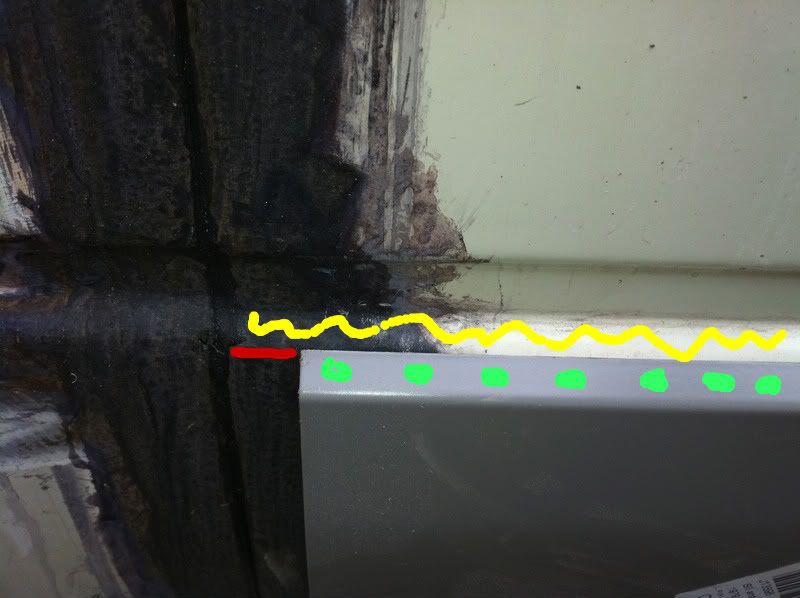Page 9 of 9
Re: Offside sill
Posted: 31 Jul 2010, 14:43
by AngeloEvs
PeteIOM wrote:
Heh... cheers.. although no matter how many times I read about them.. I still actually picture in my mind what it does

.. read it and read it again... just can't visulise whats going on when used

A joggler is a hand operated forming tool/hole punch. It allows you to create lap joints and have the two panels at the same height.
In the pics below (using odd sheets of mild steel to demo), I have created a step along one panel by running the joggler along the edge and squeezing the handles. You can see where I have stopped as the step dissappears. Simple to do but run along the edge a couple of times.
The other panel has series of holes punched, once again, easy to do - just rotate the head on the joggler (as easy as punching holes in paper!)
Overlay the panels and 'voila', you can puddle weld each hole (easiest form of welding for a newbie) and later weld along the joint (or lead load) if you think appropriate. Most often a few tacks along the way is sufficient unless the panel is subjected to a lot of stress. Flush any high spots with your angle grinder and tap back any high spots in the panel with a block of wood if necessary.
Some panel work involves slight curves across the X axis and the 'step' can sometimes interfere with it following the natural curve of the panel youer welding on to. If so, I cut slots into the step (at curve points) and this allows the stepped section to follow the line of the panel your welding on to. Most of the time its not a problem but worth mentioning.


Re: Offside sill
Posted: 31 Jul 2010, 19:25
by PeteIOM
arrr thank you soo much, that's a quality post.. totally understand it now.
Thanks!

Re: Offside sill
Posted: 31 Jul 2010, 20:15
by Plasticman
Thats nice , a picture tells a thousand words.
mike
Re: Offside sill
Posted: 01 Aug 2010, 12:24
by PeteIOM
So.. what I was thinking was...
Cut original panel where red line is (all way along).
Joggle (is that what you do with joggler?:)) along the wavy yellow line on the original panel and then hole punch (green spots) the repair panel.. offer it up and plug weld..

Does this sound about right... any reason why I wouldn't do it this way?
Re: Offside sill
Posted: 01 Aug 2010, 12:30
by dugcati
Thats were I would join it - as there is a bend in the sheet at that point it's stiffer and less likely to bend, also you can fill and shape better afterwards as you have line/s to work to
Re: Offside sill
Posted: 01 Aug 2010, 12:51
by AngeloEvs
That type of section isn't suitable for a joggler to form a step as it has a bend too close to the edge but the hole punch would be useful. I would probably just lap weld but alter the angle so that the new panel sits under or over the existing edge you have marked with a yellow line. My aim would be to keep the existing line along the panel flute as true as possible without creating a rust trap with condensation running downwards. I would probably cut a slot at each end of the existing flute, bend the existing section slightly downwards using flat steel bar and then lap weld the new panel over the existing panel. See what others suggest..........

Re: Offside sill
Posted: 01 Aug 2010, 13:21
by ianboydsnr
Unless its absolutly neccessary I would avoid joining in the place you suggest, and come slightly down from the swage line, its much more difficult to fill and prep the swage line area to a high standard, easiest would be to come down from the swage line a little, joddle the repair panel, then seam weld, either seam sealing or lead loading the rear, but if your a good welder, then butt welding is best.
just my opinion

Re: Offside sill
Posted: 01 Aug 2010, 16:17
by AngeloEvs
if the panel is in good nick below the flute (swage line) then that woud be the best option no doubt......

Re: Offside sill
Posted: 01 Aug 2010, 20:57
by Plasticman
Cut below the swage line , I would aim to have the new panel finnishing about 1/4 below the swage, as said less distortion and easier for you to fill, If you were going to lead it then do it to the face and this is the finnished surface, dont waste time leading the rear. if your going to fill it then no problem but make sure you treat and seal the rear side
mike
.. read it and read it again... just can't visulise whats going on when used


